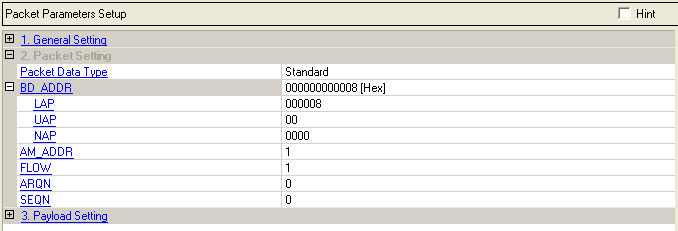

Choice: Standard | All Data
Default: Standard
Double-click or use the drop-down menu to select the packet data type.
Standard: using packet type information to generate packet data.
All Data: using raw data for packet data.
Range: 0x000000000000 to 0xFFFFFFFFFFFF
Default: 0x000000000008
Each Bluetooth device shall be allocated a unique 48-bit Bluetooth device address (BD_ADDR). This address shall be obtained from the IEEE Registration Authority. The address is divided into three fields: LAP, UAP and NAP. The structure of BD_ADDR is as follows:
|
|
|
||||||||||
|
|
|
|
|||||||||
|
0000 |
0001 |
0000 |
0000 |
0000 |
0000 |
0001 |
0100 |
0111 |
1011 |
0011 |
0101 |
Range: 0x000000 to 0xFFFFFF
Default: 0x000008
This 24-bit field shall contain the lower address part of the device.
Range: 0x00 to 0xFF
Default: 0x00
This 8-bit field should contain the upper address part of the device.
Range: 0x0000 to 0xFFFF
Default: 0x0000
This 16-bit filed should contain the non-significant address part of the device.
The LAP and UAP form the significant part of the BD_ADDR. The bit pattern in Figure below is an example BD_ADDR.
Range: 0 to 7
Default: 1
Set the logical transport address in the packet header. The header field is created using the type code of the selected packet type and the active member address (AM ADDR) of the Bluetooth device for which the packet is intended. The AM ADDR is a 3-bit address used to distinguish between the active participating slaves on a piconet. To configure the AM ADDR, enter the 3-bit address in octal notation (most significant bit to least significant bit).
Range: 0 to1
Default: 1
Set the flow control bit in the packet header.
Range: 0 to 1
Default: 0
Set the ARQ control bit in the packet header. The 1-bit acknowledgment indication ARQN is used to inform the source of a successful transfer of payload data with CRC, and can be positive acknowledge ACK or negative acknowledge NAK.
Range: 0 to 1
Default: 0
Set the sequential number index in the packet header. In Multiple Packet distribution case, the SEQN bit will be set automatically. In the first CRC data packet at the start of the connection, SEQN shall be set to 1. If a new packet is sent, the value of SEQN will be toggled. If the number of total packet is not even, a padding packet will be added to keep the SEQN toggling rule.